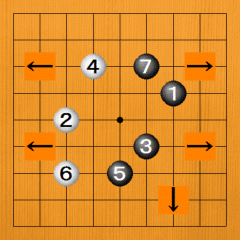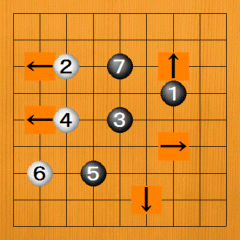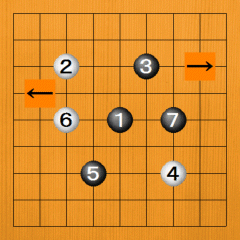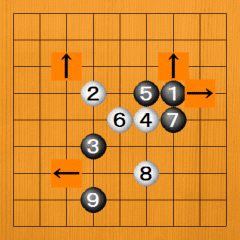 |
[2]Model game on a 9x9 board

· Let's look at how to play on a 9x9 board.
· If we look at the course of this game up to 7, Black is enclosing the right side and White the left side. The arrows on the right show the area that is likely to become black territory and the arrows on the left the area that is likely to become white territory. This game is easy to understand. |
 |

Dia. 4 |
|
· Dia. 5. How about this game? Black is building a big potential area while White is just building a narrow area on the left. Don't you have a feeling that in the future Black's territory is going to be bigger than White's? You don't have to understand the details at this stage; it's enough just to get a vague feeling for the situation. |
 |

Dia. 5 |
 |
· Dia. 6. In this diagram, White has played 2 in the top left and 4 in the bottom right. Black has occupied the top right and the bottom left. The arrow on the right shows Black's probable territory. The arrow on the left shows White's probable territory. Please pay attention to White 4. Will it be able to make its own territory? It's surrounded by black stones in the neighbourhood, so its isolated position is worrying.
How about looking at it from Black's point of view? Black may actually be having trouble working out how to deal with this stone. The interesting thing about Go is that both sides play each move while worrying about various problems. It's not enough just to follow the manual. The feature of Go is that you have to do your own thinking. Please enjoy this marvelous game in which innovation and originality are important. |
 |

Dia. 6 |
 |
|
· Dia. 7. Black 1 is similar to the moves we have seen so far, but Black answers White 2 by making contact with Black 3. What could be the meaning of Black 5? Black 3 and 5 are not connected. White 2 and 4 are not connected, either. At first, you may not know what to do after this, but discovering your own answer is the essence of Go. Try to do your own thinking. The more you think, the more you will come to understand the world of Go. |
 |
Dia. 7
|
 |
|
· (Application) Dia. 8. This is another complicated position. At first, Black plays on the right side with 1 and White plays on the left with 2. These stones are separated from each other, but after Black plays 3 on the bottom left, a confusing fight starts with White 4. After 5 and 7, the area in the top right looks like becoming Black's territory. And the two black stones 3 and 9 seem to be claiming the area indicated by the arrow here as black territory. White has occupied the top left, but what will happen to White 8 in the bottom right? White 4 and 6 are nearby, so this stone is not isolated. But does it look as if White will secure the bottom right area as territory? Black 7 is nearby, so one can't say. We would have to see how the game continued. It's not strange to have a situation like this, where the prospects for some areas are clear but the prospects for other areas are not. Go is a game in which you play moves while thinking about these unclear areas. While you play, you gradually secure your own territory and reduce the opponent's territory and clear up these unclear areas. That's the fun of Go. |
 |

Dia. 8 |
 |
| Not even a top professional player, that is, a master player, knows everything about the game of Go. Of course, the things that puzzle him are different from what puzzles a beginner or an average player, but even so there are many things he doesn't understand, so in that way he's no different. Go can't be completely analysed even with the most modern computers. Even the best Go-playing software can't beat a strong amateur, let alone a professional. Computers are very good a calculating and playing set sequences, but they are not good at puzzling over alternatives in ambiguous positions. These moves you have to puzzle over are the essence of Go, and for the time being computers are not going to be a threat to professionals. However, computers are useful for practice for beginners, so in due course we will introduce you to them. |
|
 |